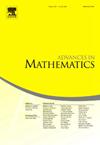最小连接的单调性公式
IF 1.5
1区 数学
Q1 MATHEMATICS
引用次数: 0
摘要
对于黎曼流形(X,g)上的厄米复线束上的厄米连接,我们可以定义“体积”,它可以被认为是子流形标准体积的“镜像”。我们称临界点为最小连接。在本文中,(1)我们证明了在一定条件下关于某些体积泛函的最小连接的单调性公式。这些公式在冒泡分析中是很重要的。作为一个推论,我们得到了奇维欧几里德空间上最小连接的消失定理。(2)我们看到最小连接定义方程的形式“大半径极限”是Yang-Mills连接的极限。然后证明了“足够大”度规下极小连接的存在性定理。(3)我们可以将g2流形上的变形Donaldson-Thomas (dDT)连接视为校准(联想)子流形的“镜子”。我们证明滴滴涕连接是最小连接,就像校准子流形是最小子流形一样。通过对滴滴涕连接的论证,我们得到了滴滴涕连接比(1)更强的单调性公式和消失定理。本文章由计算机程序翻译,如有差异,请以英文原文为准。
A monotonicity formula for minimal connections
For Hermitian connections on a Hermitian complex line bundle over a Riemannian manifold , we can define the “volume”, which can be considered to be the “mirror” of the standard volume for submanifolds. We call the critical points minimal connections.
In this paper, (1) we prove monotonicity formulas for minimal connections with respect to some versions of volume functionals under certain conditions on and the curvature of g. These formulas would be important in bubbling analysis. As a corollary, we obtain the vanishing theorem for minimal connections on the odd dimensional Euclidean space.
(2) We see that the formal “large radius limit” of the defining equation of minimal connections is that of Yang–Mills connections. Then the existence theorem of minimal connections is proved for a “sufficiently large” metric.
(3) We can consider deformed Donaldson–Thomas (dDT) connections on -manifolds as “mirrors” of calibrated (associative) submanifolds. We show that dDT connections are minimal connections, just as calibrated submanifolds are minimal submanifolds. By the argument specific to dDT connections, we obtain the stronger monotonicity formulas and vanishing theorem for dDT connections than in (1).
求助全文
通过发布文献求助,成功后即可免费获取论文全文。
去求助
来源期刊

Advances in Mathematics
数学-数学
CiteScore
2.80
自引率
5.90%
发文量
497
审稿时长
7.5 months
期刊介绍:
Emphasizing contributions that represent significant advances in all areas of pure mathematics, Advances in Mathematics provides research mathematicians with an effective medium for communicating important recent developments in their areas of specialization to colleagues and to scientists in related disciplines.
 求助内容:
求助内容: 应助结果提醒方式:
应助结果提醒方式:


